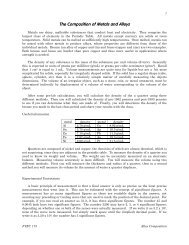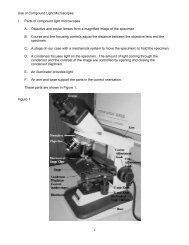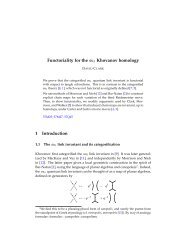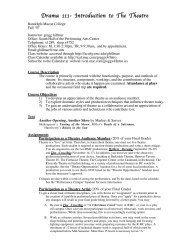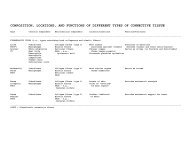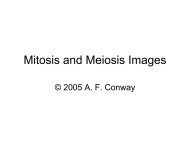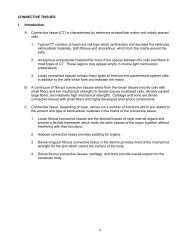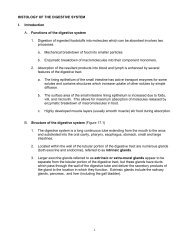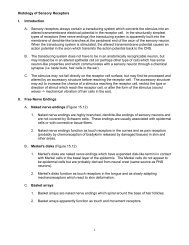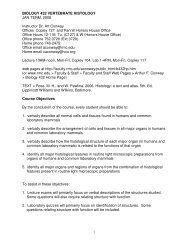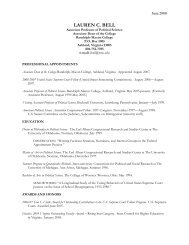Histology of the Human Ear I. External ear (Figure ... - Faculty.rmc.edu
Histology of the Human Ear I. External ear (Figure ... - Faculty.rmc.edu
Histology of the Human Ear I. External ear (Figure ... - Faculty.rmc.edu
You also want an ePaper? Increase the reach of your titles
YUMPU automatically turns print PDFs into web optimized ePapers that Google loves.
(2) Function<br />
(a) Sound waves in <strong>the</strong> air enter <strong>the</strong> outer <strong>ear</strong> and cause vibrations <strong>of</strong> <strong>the</strong><br />
tympanic membrane (<strong>ear</strong>drum).<br />
(b) Vibration <strong>of</strong> <strong>the</strong> tympanic membrane causes vibrations <strong>of</strong> <strong>the</strong> middle <strong>ear</strong><br />
ossicles.<br />
(c) Vibration <strong>of</strong> <strong>the</strong> stapes causes vibration <strong>of</strong> <strong>the</strong> oval window in <strong>the</strong> surface <strong>of</strong><br />
<strong>the</strong> vestibular canal at <strong>the</strong> base <strong>of</strong> <strong>the</strong> cochlea.<br />
(d) Vibration <strong>of</strong> <strong>the</strong> oval window causes vibration (pressure waves) in <strong>the</strong> fluid<br />
<strong>of</strong> <strong>the</strong> vestibular canal and (through its communication with <strong>the</strong> tympanic<br />
canal at <strong>the</strong> apex <strong>of</strong> <strong>the</strong> cochlea) <strong>the</strong> tympanic canal.<br />
(e) Where <strong>the</strong> pressure waves in <strong>the</strong> outer canals (vestibular and tympanic)<br />
are out <strong>of</strong> phase, <strong>the</strong>y result in vertical vibration <strong>of</strong> <strong>the</strong> organ <strong>of</strong> Corti.<br />
(f) Vertical movement <strong>of</strong> <strong>the</strong> organ <strong>of</strong> Corti causes <strong>the</strong> tectorial membrane to<br />
move laterally on <strong>the</strong> surface <strong>of</strong> <strong>the</strong> hair cells. The conversion <strong>of</strong> vertical<br />
movement into lateral movement is due to <strong>the</strong> lack <strong>of</strong> movement <strong>of</strong> <strong>the</strong><br />
attachment <strong>of</strong> <strong>the</strong> tectorial membrane and <strong>the</strong> sensory epi<strong>the</strong>lium with <strong>the</strong><br />
osseus spiral lamina.<br />
(g) This system converts both frequency (determines <strong>the</strong> location along <strong>the</strong><br />
organ <strong>of</strong> Corti at which maximum vibration occurs) and intensity<br />
(determines <strong>the</strong> extent <strong>of</strong> <strong>the</strong> vibrating area) <strong>of</strong> sound into mechanical<br />
movement <strong>of</strong> hair cell processes. Fur<strong>the</strong>r processing <strong>of</strong> <strong>the</strong> signal in <strong>the</strong><br />
spiral ganglion and in <strong>the</strong> auditory centers in <strong>the</strong> brain app<strong>ear</strong> necessary to<br />
produce <strong>the</strong> ability to discriminate among sounds that is demonstrated by<br />
musicians.<br />
6



